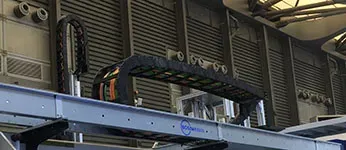Choosing the Right Cable Carrier for Efficient Hoisting Systems and Applications
Cable Carrier for Hoists Elevating Efficiency and Safety
In the realm of industrial applications, hoists play a critical role in lifting and moving heavy loads, making them indispensable in construction sites, warehouses, factories, and other workplaces. However, to optimize the functionality of these hoists, the integration of a reliable cable carrier is essential. A cable carrier, also known as a drag chain or cable track, is designed to protect and manage the cables and hoses associated with moving machinery. This article delves into the significance, advantages, and types of cable carriers for hoists.
Understanding the Functionality of Cable Carriers
Cable carriers serve the primary purpose of guiding and protecting electrical cables and hoses during operation. In the context of hoists, these carriers facilitate smooth movement while ensuring that the cables do not become tangled, damaged, or subject to excessive wear and tear. This is particularly important in environments where the hoist equipment may move in a linear or multi-axial direction. Implementing a cable carrier system reduces downtime, prolongs the lifespan of cables, and enhances the overall productivity of the operation.
Benefits of Cable Carriers for Hoists
1. Enhanced Safety One of the most significant advantages of using a cable carrier is the enhancement of safety in the workplace. By keeping cables organized and contained, the risk of tripping hazards or accidental damage to cables is minimized. This is especially crucial in high-traffic areas where workers operate lifting equipment.
2. Improved Durability Cable carriers are designed to withstand harsh environments, including exposure to dust, moisture, and mechanical stress. This durability translates into less frequent replacements of cables, leading to reduced maintenance costs and operational disruptions.
3. Increased Mobility A well-designed cable carrier allows for smooth and unrestricted movement of the hoist equipment. This is vital in applications where precise positioning and rapid movement are required, as it ensures that performance levels remain high without the encumbrance of tangled cords or snags.
4. Optimized Space Management Utilizing cable carriers can help optimize vertical and horizontal space in an industrial setting. Instead of having cables sprawled across an area, cable carriers can manage the cables efficiently, maintaining a clean and organized workspace.
cable carrier for hoist

5. Customization Options Many manufacturers offer customizable cable carriers that can be adapted to specific applications and load requirements. They can be tailored in terms of size, shape, and material to meet the unique demands of diverse industries.
Types of Cable Carriers
When selecting a cable carrier for hoists, it is essential to consider various types to find the best match for specific applications. Some common types include
- Plastic Cable Carriers Lightweight and cost-effective, plastic carriers are suitable for lighter loads and applications with minimal exposure to harsh conditions.
- Steel Cable Carriers Known for their strength and durability, steel carriers are ideal for heavy-duty applications and environments where high wear is expected.
- Modular Cable Carriers These carriers can be built and adjusted to meet fluctuating operational needs, allowing for flexibility in configurations.
- Low-Friction Cable Carriers Designed for applications requiring smooth, quiet operation, low-friction systems can significantly enhance the efficiency of hoist operations.
In conclusion, integrating a cable carrier system with hoist operations is not merely a functional component; it is a crucial investment in the safety, efficiency, and longevity of industrial processes. By leveraging the benefits of cable carriers, businesses can ensure that their hoists operate seamlessly and safely in various environments. As industries evolve and demand higher performance from lifting equipment, the importance of effective cable management will only continue to grow.








